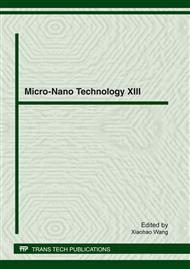[1]
S. W. Youn, Toshihiko Noguchi, Masaharu Takahashi, et al. Dynamic mechanical thermal analysis, forming and mold fabrication studies for hot-embossing of a polyimide microfluidic platform, MICROMECHANICS AND MICROENGINEERING, 18(2008)045025 (9pp).
DOI: 10.1088/0960-1317/18/4/045025
Google Scholar
[2]
J. M. Li, C. Liu, H. C. Qiao, et al. Hot embossing/bonding of a poly(ethylene terephthalate) (PET) microfluidic chip, MICROMECHANICS AND MICROENGINEERING, 18(2008)015008 (10pp).
DOI: 10.1088/0960-1317/18/1/015008
Google Scholar
[3]
S. Malahat, P. G. Iovenitti, I, Sbarski. Influence of tool fabrication process on characteristics of hotembossed polymer microfluidic chips for electrospray, MICROSYST TECHNOL, (2010) 16: 2075–(2085).
DOI: 10.1007/s00542-010-1135-4
Google Scholar
[4]
P. P. Shiu, G. K. Knopf, M. Ostojic, et al. Rapid fabrication of tooling for microfluidic devices via lasermicromachining and hot embossing, MICROMECHANICS AND MICROENGINEERING, 18 (2008) 025012(8pp).
DOI: 10.1088/0960-1317/18/2/025012
Google Scholar
[5]
J. Y. Cheng, M. H. Yen, C. W. Wei, et al. Crack-free direct-writing on glass using a low-power UV laser in the manufacture of a microfluidic chip, MICROMECHANICS AND MICROENGINEERING, 15 (2005) 1147–1156.
DOI: 10.1088/0960-1317/15/6/005
Google Scholar
[6]
A. A. Said, M. Dugan, P. Bado, et al. Manufacturing by laser direct-write of three-dimensional devices containing optical and microfluidic networks, PHOTON PROCESSING IN MICROELECTRONICS AND PHOTONICS III, Proc. of SPIE Vol. 5339.
DOI: 10.1117/12.533540
Google Scholar
[7]
S. Queste, R. Salut, S. Clatot, et al. Manufacture of microfluidic glass chips by deep plasma etching, femtosecond laser ablation, and anodic bonding, MICROSYST TECHNOL, (2010) 16: 1485–1493.
DOI: 10.1007/s00542-010-1020-1
Google Scholar
[8]
S. Metz, C. Trautmann, A. Bertsch, et al. Polyimide microfluidic devices with integrated nanoporous filtration areas manufactured by micromachining and ion track technology, MICROMECHANICS AND MICROENGINEERING, 14 (2004) 324–331.
DOI: 10.1088/0960-1317/14/3/002
Google Scholar


